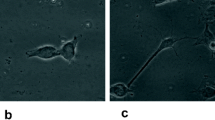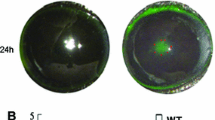Abstract
Cell migration depends on the generation of structural asymmetry and on different steps: protrusion and adhesion at the front and traction and detachment at the rear part of the cell. The activity of Ca2+ channels coordinate these steps by arranging intracellular Ca2+ signals along the axis of movement. Here, we investigated the role of the putative mechanosensitive canonical transient receptor potential channel 1 (TRPC1) in cell migration. We analyzed its function in transformed renal epithelial (Madin–Darby canine kidney-focus) cells with variation of TRPC1 expression. As shown by time lapse video microscopy, TRPC1 knockdown cells have partially lost their polarity and the ability to persistently migrate into a given direction. This failure is linked to the suppression of a local Ca2+ gradient at the front of migrating TRPC1 knockdown cells, whereas TRPC1 overexpression leads to steeper Ca2+ gradients. We propose that the Ca2+ signaling events regulated by TRPC1 within the lamellipodium determine polarity and directed cell migration.









Similar content being viewed by others
References
Arora PD, McCulloch CA (1996) Dependence of fibroblast migration on actin severing activity of gelsolin. J Biol Chem 271:20516–20523
Bamburg JR (1999) Proteins of the ADF/cofilin family: essential regulators of actin dynamics. Annu Rev Cell Dev Biol 15:185–230
Bowman CL, Gottlieb PA, Suchyna TM, Murphy YK, Sachs F (2007) Mechanosensitive ion channels and the peptide inhibitor GsMTx-4: history, properties, mechanisms and pharmacology. Toxicon 49:249–270
Brummelkamp TR, Bernards R, Agami R (2002) A system for stable expression of short interfering RNAs in mammalian cells. Science 296:550–553
Brundage RA, Fogarty KE, Tuft RA, Fay FS (1993) Chemotaxis of newt eosinophils: calcium regulation of chemotactic response. Am J Physiol 265:C1527–C1543
Delorme V, Machacek M, DerMardirossian C, Anderson KL, Wittmann T, Hanein D, Waterman-Storer C, Danuser G, Bokoch GM (2007) Cofilin activity downstream of Pak1 regulates cell protrusion efficiency by organizing lamellipodium and lamella actin networks. Dev Cell 13:646–662
Dieterich P, Klages R, Preuss R, Schwab A (2008) Anomalous dynamics of cell migration. Proc Natl Acad Sci U S A 105:459–463
Doyle AD, Lee J (2005) Cyclic changes in keratocyte speed and traction stress arise from Ca2+-dependent regulation of cell adhesiveness. J Cell Sci 118:369–379
Doyle A, Marganski W, Lee J (2004) Calcium transients induce spatially coordinated increases in traction force during the movement of fish keratocytes. J Cell Sci 117:2203–2214
Dreval V, Dieterich P, Stock C, Schwab A (2005) The role of Ca2+ transport across the plasma membrane for cell migration. Cell Physiol Biochem 16:119–126
Eddy RJ, Pierini LM, Matsumura F, Maxfield FR (2000) Ca2+-dependent myosin II activation is required for uropod retraction during neutrophil migration. J Cell Sci 113(Pt 7):1287–1298
Franco SJ, Huttenlocher A (2005) Regulating cell migration: calpains make the cut. J Cell Sci 118:3829–3838
Glogauer M, Arora P, Yao G, Sokholov I, Ferrier J, McCulloch CA (1997) Calcium ions and tyrosine phosphorylation interact coordinately with actin to regulate cytoprotective responses to stretching. J Cell Sci 110(Pt 1):11–21
Gottlieb P, Folgering J, Maroto R, Raso A, Wood TG, Kurosky A, Bowman C, Bichet D, Patel A, Sachs F, Martinac B, Hamill OP, Honore E (2008) Revisiting TRPC1 and TRPC6 mechanosensitivity. Pflugers Arch 455(6):1097–1103
Grynkiewicz G, Poenie M, Tsien RY (1985) A new generation of Ca2+ indicators with greatly improved fluorescence properties. J Biol Chem 260:3440–3450
Hahn K, DeBiasio R, Taylor DL (1992) Patterns of elevated free calcium and calmodulin activation in living cells. Nature 359:736–738
Hamill OP, Martinac B (2001) Molecular basis of mechanotransduction in living cells. Physiol Rev 81:685–740
Huang JB, Kindzelskii AL, Clark AJ, Petty HR (2004) Identification of channels promoting calcium spikes and waves in HT1080 tumor cells: their apparent roles in cell motility and invasion. Cancer Res 64:2482–2489
Jacques-Fricke BT, Seow Y, Gottlieb PA, Sachs F, Gomez TM (2006) Ca2+ influx through mechanosensitive channels inhibits neurite outgrowth in opposition to other influx pathways and release from intracellular stores. J Neurosci 26:5656–5664
Kimura C, Oike M, Koyama T, Ito Y (2001) Alterations of Ca2+ mobilizing properties in migrating endothelial cells. Am J Physiol Heart Circ Physiol 281:H745–H754
Kindzelskii AL, Petty HR (2005) Ion channel clustering enhances weak electric field detection by neutrophils: apparent roles of SKF96365-sensitive cation channels and myeloperoxidase trafficking in cellular responses. Eur Biophys J 35:1–26
Komuro H, Rakic P (1996) Intracellular Ca2+ fluctuations modulate the rate of neuronal migration. Neuron 17:275–285
Lawson MA, Maxfield FR (1995) Ca(2+)- and calcineurin-dependent recycling of an integrin to the front of migrating neutrophils. Nature 377:75–79
Lee J, Ishihara A, Oxford G, Johnson B, Jacobson K (1999) Regulation of cell movement is mediated by stretch-activated calcium channels. Nature 400:382–386
Li Y, Jia YC, Cui K, Li N, Zheng ZY, Wang YZ, Yuan XB (2005) Essential role of TRPC channels in the guidance of nerve growth cones by brain-derived neurotrophic factor. Nature 434:894–898
Mandeville JT, Ghosh RN, Maxfield FR (1995) Intracellular calcium levels correlate with speed and persistent forward motion in migrating neutrophils. Biophys J 68:1207–1217
Maroto R, Raso A, Wood TG, Kurosky A, Martinac B, Hamill OP (2005) TRPC1 forms the stretch-activated cation channel in vertebrate cells. Nat Cell Biol 7:179–185
Munevar S, Wang YL, Dembo M (2004) Regulation of mechanical interactions between fibroblasts and the substratum by stretch-activated Ca2+ entry. J Cell Sci 117:85–92
Oberleithner H, Westphale HJ, Gassner B (1991) Alkaline stress transforms Madin–Darby canine kidney cells. Pflugers Arch 419:418–420
Pedersen SF, Nilius B (2007) Transient receptor potential channels in mechanosensing and cell volume regulation. Methods Enzymol 428:183–207
Ponti A, Machacek M, Gupton SL, Waterman-Storer CM, Danuser G (2004) Two distinct actin networks drive the protrusion of migrating cells. Science 305:1782–1786
Rao JN, Platoshyn O, Golovina VA, Liu L, Zou T, Marasa BS, Turner DJ, Yuan JX, Wang JY (2006) TRPC1 functions as a store-operated Ca2+ channel in intestinal epithelial cells and regulates early mucosal restitution after wounding. Am J Physiol Gastrointest Liver Physiol 290:G782–G792
Raucher D, Sheetz MP (2000) Cell spreading and lamellipodial extension rate is regulated by membrane tension. J Cell Biol 148:127–136
Ridley AJ, Schwartz MA, Burridge K, Firtel RA, Ginsberg MH, Borisy G, Parsons JT, Horwitz AR (2003) Cell migration: integrating signals from front to back. Science 302:1704–1709
Schneider SW, Pagel P, Rotsch C, Danker T, Oberleithner H, Radmacher M, Schwab A (2000) Volume dynamics in migrating epithelial cells measured with atomic force microscopy. Pflugers Arch 439:297–303
Schwab A, Finsterwalder F, Kersting U, Danker T, Oberleithner H (1997) Intracellular Ca2+ distribution in migrating transformed epithelial cells. Pflugers Arch 434:70–76
Schwab A, Rossmann H, Klein M, Dieterich P, Gassner B, Neff C, Stock C, Seidler U (2005) Functional role of Na+-HCO3-cotransport in migration of transformed renal epithelial cells. J Physiol 568(Pt 2):445–458
Schwab A, Nechyporuk-Zloy V, Fabian A, Stock C (2007) Cells move when ions and water flow. Pflugers Arch 453:421–432
Sharif-Naeini R, Dedman A, Folgering JH, Duprat F, Patel A, Nilius B, Honore E (2008) TRP channels and mechanosensory transduction: insights into the arterial myogenic response. Pflugers Arch DOI 10.1007/s00424-007-0432-y
Spassova MA, Hewavitharana T, Xu W, Soboloff J, Gill DL (2006) A common mechanism underlies stretch activation and receptor activation of TRPC6 channels. Proc Natl Acad Sci U S A 103:16586–16591
Suchyna TM, Johnson JH, Hamer K, Leykam JF, Gage DA, Clemo HF, Baumgarten CM, Sachs F (2000) Identification of a peptide toxin from Grammostola spatulata spider venom that blocks cation-selective stretch-activated channels. J Gen Physiol 115:583–598
Wang GX, Poo MM (2005) Requirement of TRPC channels in netrin-1-induced chemotropic turning of nerve growth cones. Nature 434:898–904
Wang Y, Shibasaki F, Mizuno K (2005) Calcium signal-induced cofilin dephosphorylation is mediated by slingshot via calcineurin. J Biol Chem 280:12683–12689
Waning J, Vriens J, Owsianik G, Stuwe L, Mally S, Fabian A, Frippiat C, Nilius B, Schwab A (2007) A novel function of capsaicin-sensitive TRPV1 channels: involvement in cell migration. Cell Calcium 42:17–25
Wes PD, Chevesich J, Jeromin A, Rosenberg C, Stetten G, Montell C (1995) TRPC1, a human homolog of a Drosophila store-operated channel. Proc Natl Acad Sci U S A 92:9652–9656
Zhu X, Chu PB, Peyton M, Birnbaumer L (1995) Molecular cloning of a widely expressed human homologue for the Drosophila trp gene. FEBS Lett 373:193–198
Acknowledgments
The authors thank Michael Zhu from the Ohio State University for kindly providing us with a plasmid of the human HA-tagged TRPC1. This work was supported by a grant from the Rolf-Dierichs-Stiftung of the Medical Faculty of the University of Münster (grant number 193423) to A.F., by the IZKF Münster (grant number Schw2/030/08) and by the Deutsche Forschungsgemeinschaft (grant number Schw 407/9-3, 10-1) to A.S. B.N. was supported by a Human Frontiers Research Grant (RGP 32/2004), the Excellentiefinanciering (Flanders, EF/95/010), and the Interuniversity Poles of Attraction Program, Prime Minister’s Office IUAP.
Author information
Authors and Affiliations
Corresponding author
Electronic supplementary material
Below is the link to the electronic supplementary material.
424_2008_515_MOESM1_ESM.mov
Video 1 Suppression of TRPC1 leads to loss of cellular polarity and impaired migration. Phase-contrast time lapse video microscopy of representative MDCK-F cells migrating on fibronectin for 3 h. Frames were collected in 1-min intervals and are displayed at a rate of 30 frames per second. Cells with knockdown of TRPC1 are shown in the left panel and hTRPC1-HA-overexpressing cells in the right panel. TRPC1 knockdown leads to a loss of cell polarity. A clear front-rear axis can no longer be recognized. Multiple broad lamellipodia are protruding into different directions simultaneously. In contrast, hTRPC1-HA-overexpressing cells are highly polarized and show a normal and efficient migration. As movies are shown in the same magnification, it is obvious that the projected cell surface of TRPC1-depleted cells has at least doubled. Scale bar: 50 µm. (MOV 2.78 MB)
Rights and permissions
About this article
Cite this article
Fabian, A., Fortmann, T., Dieterich, P. et al. TRPC1 channels regulate directionality of migrating cells. Pflugers Arch - Eur J Physiol 457, 475–484 (2008). https://doi.org/10.1007/s00424-008-0515-4
Received:
Revised:
Accepted:
Published:
Issue Date:
DOI: https://doi.org/10.1007/s00424-008-0515-4




